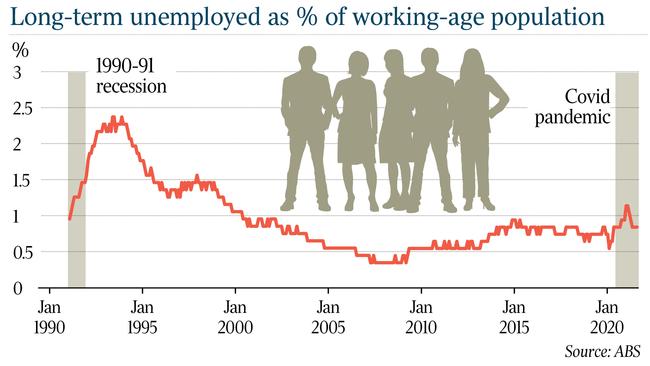Shrinking dole queue defies Covid-19 Delta downturn
Another 45,000 people dropped off unemployment benefits over the month to early November, in a further sign of the labour market’s resilience.

A further 45,000 people dropped off unemployment benefits over the month to early November, in a further sign of the labour market’s resilience through the final weeks of the Delta lockdowns.
Department of Social Services figures obtained by The Australian show the number of JobSeeker and Youth Allowance (Other) recipients dropped by 92,000 since the third wave of Covid-19 infections plunged Sydney into lockdown at the end of June.
However, welfare dependency has remained high. There were just over one million dole recipients as at November 5 – 200,000 more than immediately before the pandemic arrived on Australian shores. The figure peaked at 1.6 million in May last year.
In a report released on Thursday, the Australian Council of Social Service argued long-term unemployment was at “crisis levels”, pointing to the fact that as at June there were more Australians on unemployment benefits for longer than a year than in the 1990s recession.
But Social Services Minister Anne Ruston said “it is clear that there are employers desperate for more workers, with job ads reaching a 13-year high this week”.
“My message to all job seekers is consider looking for work that is outside your past experience or even take the opportunity to head to the regions,” Senator Ruston said.
ABS head of labour force statistics Bjorn Jervis said “there was no evidence in the labour statistics that there has been a major structural change where there are more people who are persistently unable to get back into work”.

“We are 18 months into a pandemic, so some of these (phenomena) may not reflect structural changes; they may reflect the types of jobs where there are still restrictions,” Mr Jervis said.
The proportion of long-term unemployed – those unable to find employment for over a year – to the working age population peaked at 2.4 per cent in mid-1993 in the wake of the previous recession, according to The Australian’s analysis of ABS data.
In contrast, this ratio only climbed as high as 1.2 per cent in April last year, and by September had returned to 0.9 per cent – the level preceding the pandemic.
Labour market experts expect the stop-start nature of the Covid recession will not leave the economic “scarring” of previous recessions, when workers in industries such as manufacturing faced the permanent closure of factories and the difficult task of transitioning into different types of jobs.
But ANU professor Peter Whiteford said that after Victoria’s second wave and the Delta disruptions it was too early to say whether the Covid recession would leave a legacy of long-term unemployment.
“We haven’t seen the full recovery in the labour market yet,” Professor Whiteford said. “As long as we don’t have a fourth wave and we open up the economy fully and international travel comes back on, I think we should have sorted this question out by the middle of next year.”




To join the conversation, please log in. Don't have an account? Register
Join the conversation, you are commenting as Logout